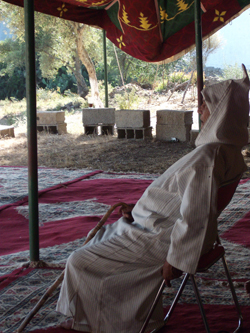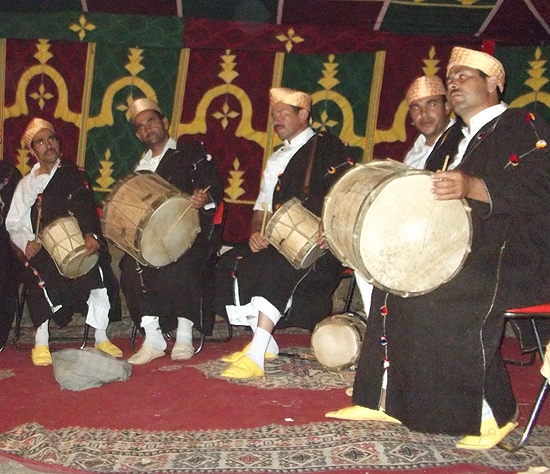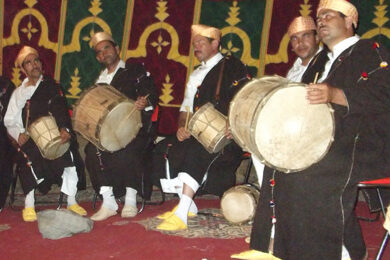"Alright mate? What are you lot doing here?"
We are standing at the entrance of the Ksar El Kebir train station, a one and a half hour journey south from Tangier. The south London accent catches us off guard, and we recognise the speaker as a Moroccan who had sat behind us on our plane from Heathrow a couple of days previously.
"This is my home town. No one ever comes here," he says, surprised at our presence. But we are simply passing through. We say we are going to the village of Joujouka. He has never heard of it.
The tiny village (population around 200) is set in the Ahl Srif mountain range of the southern Rif Mountains in northern Morocco. Ksar El Kebir is the nearest town. For so long the gates of this remote village, home to the legendary Master Musicians of Joujouka, seemed open only to a handful of open minds, subversive spirits and enlightenment seekers from the counterculture movement.
The first noted visitors included Tangier-based writers and artists Brion Gysin, William S Burroughs and Paul Bowles; LSD guru Timothy Leary; and, perhaps most famously, Rolling Stones member Brian Jones. They had been introduced to the village by "painter of Morocco" and Joujouka native Hamri, who no doubt felt that the music from the village would strike a chord, so to speak, if heard by the right ears. Gysin felt such an affinity to the music he opened up a restaurant so he could hear them play every night – The 1001 Nights, in Tangier – with the Master Musicians of Joujouka as the house band.
In 1968 Jones travelled to North Africa and made the trek to the Rif Mountains to visit Joujouka. Armed with recording equipment, Jones documented the new sounds he was hearing and the tapes were later released in 1971 as Brian Jones Presents the Pipes of Pan at Joujouka.
Free jazz legend Ornette Coleman followed, visiting the village in 1973 to record ‘Midnight Sunrise’, which appears on his Dancing In Your Head album. And now you too can visit Joujouka as part of the annual "Boujeloud" festival, a three day event based on the traditional week-long Islamic feast Eid el-Kebir that has been held annually in the village for hundreds of years.
Like Delta bluesman Robert Johnson selling his soul to the devil at the crossroads in return for his rare gift, the history of Boujeloud is a rock ‘n’ roll tale with mythical origins. That legend begins with Attar, a young shepherd, who dared to rest in the forbidden cave of Magara (pronounced Ma’ara), near Joujouka, while his flock grazed on the greenery below. The cave was seen as taboo by villagers and, soon enough, Attar was roused from his slumber by the sound of pipes being played by the part-goat, part-man figure of Boujeloud – the "father of the skins". Boujeloud made a deal with Attar that he would teach him the secrets of the music, in return that he never share them. If he did break this vow, his teacher would be entitled to take a bride from the village. Alas, Attar couldn’t keep the music to himself, and was heard playing by an infuriated Boujeloud, who came to take his promised bride. The villagers kept to the bargain, but presented Boujelord with the mad Aisha Kandisha, who tired him out with her insane dancing. Although briefly gratified, Boujeloud could eventually take no more, and left the village alone. Following his departure the villagers enjoyed a successful harvest.
The ritual would continue each year, and time after time, Boujeloud would leave without a woman, and a rich harvest would follow. When Boujeloud finally vanished for good, Attar continued the ritual by dressing in goatskins himself, dancing with local boys taking on on the role of "Crazy Aisha". And this is effectively what continues to this day. Gysin likened Boujeloud to the mythical figure of Pan, and in turn, the whole ritual to the Rites of Pan, events historians had hitherto believed were no longer performed.
With its dusty, orange pebbly paths, ramshackle whitewashed buildings with corrugated roofs, stray donkeys, goats and chickens wandering around and the large village square, complete with well, Joujouka could be the setting for a spaghetti western. But there is no need for a Morricone soundtrack in these mountains. As incredible as the surroundings are, we are here to see and hear the Master Musicians of Joujouka perform their mesmerising sufi mantras.
Leary called them the "4,000 year old rock ‘n’ roll band", the music having been passed down from father to son, from Attar to Attar, for generation after generation. For the first evening’s performance of the festival the group, led by Ahmed El Attar, consists of an impressive seven rhaita (a double reeded oboe-like instrument) players and five tebel (percussion) players. Lined up from left to right, each member resplendent in their suitably masterful outfits of an off-the-shoulder hooded brown djellaba, white shirt, yellow slippers and round flat hat, their colourful rhaita cases dangling from their wrists. A lone pipe line leads the group into action. The drummers pound out an incessant barrage of colliding patterns on their drums (with sheep hides for skins), rested on the knees and played with a spoon shaped piece of wood in one hand and a thin stick in the other. You can watch the musicians and try to work out who is playing what, but once you catch the eye of the man you’ve picked out they will instantly change the beat. The rhaita players carry on a follow-the-leader routine, constantly upping the ante, using circular breathing techniques to maintain the notes, until unified screeches ring out in ascension, building up and building up the intensity until the pitch is ringing out beyond the lavish tent that is their backdrop and high out into the hills. And oh yes, it is loud too.
Close your eyes and fall into a trance, like discovering the flickering images of Gysin’s dream machine for the first time. It’s a near-hallucinatory experience.

You may open your eyes and see one of the men from the village dancing barefoot. Eyes twitching, body fidgeting, his repetitive moves enticing and inciting the musicians at once. One by one he picks out the girls in the crowd to join him on the dancefloor made of carpets, then he works his way through the men, making sure that no one escapes the ritual.
While the visitors sit cross-legged watching in front of the band, dozens of boys and men from the village are gathered to the left. Some of the boys are not yet in their teens, some are sons of the musicians, and we wonder what they must make of their elders playing this ancient music to these strange visitors. We find out, as the next thing we know one, two, then a trio of the younger boys have leapt up and stand, arms raised, and bodies shaking from head to toe. Ecstatic dancers, they are completely in thrall to the music.
The older dancing man reappears, this time clad in an all-over black outfit, made from sewn together goat skins. This is the Pan-like and notoriously taboo fellow "Boujeloud", sheltered under a straw hat and brandishing leafy olive branches in his hands. As if possessed, he attacks the musicians, the village boys, and ourselves with his sticks. His actions are believed to bring fertility and a good harvest for the villagers. Throughout his antics the Master Musicians carry on, unperturbed, aside from the odd member dipping out for a moment to take a hit from his pipe. Two solid hours later the final notes ring out and a tricky flute line concludes the piece without a moment’s notice.
The wild music is swirling around my head as I hazily walk back in darkness to the house where we are staying in, and as I lay in bed wide awake and stunned afterwards it was those sounds that played over and over in my head for what seems like hours, disturbed only by the humming of cicadas outside. When I awake there are different sounds; dogs barking, cows mooing, cocks crowing, stray donkeys and goats bleating from down the hillside and children playing. The natural sounds encapsulate a lot of the madness contained within the music presented by the Master Musicians – a kind of traffic jam symphony composed of their natural surroundings. Ironically this is also the music believed to have healing powers to cure insanity.
The village is the resting place of Sufi mystic Sidi Achmed Sheikh, the "healer of crazy minds" and saint who brought Islam to the area around Joujouka. For centuries visitors from all around have come to his tomb at Joujouka to seek cures for madness. He is said to have given the Master Musicians the ability to heal sickness and mental illnesses. In return he was given the gift of their music. People also seek out the musicians to give them "baraka" – spiritual power.
The family name of the musicians, Attar, translates as perfume maker, and it is said by people who have spent a long time in the village that when the Masters are really on it their playing can create a sweet aroma in the air – a perfume from the music.
In the afternoons the musicians play folkier jams, with revolving musicians, and violins (played rested on the knee), lira (a quieter recorder-like flute), doumbek (drum) and occasionally oud guitars are played. Unlike the Boujeloudian suites of the evenings this music comes with singing. Song titles translate into sweet names like, ‘Your Eyes Make Me Want to Drink Tea’ and ‘Everyone Is Together’, but as they sing musicians are constantly disappearing under their hands in fits of giggles. Our suspicions of the lewd material being performed is backed up by the dirty laughter and exaggerated sexual hip shaking dance moves that accompany the sessions. It’s a far cry from the evening’s trance sessions, but equally captivating none the less. And it’s a treat to hear their version of the track ‘L’Alta (I Am Calling Out)’ – a highlight from the Brian Jones recordings.
What kind of future lies in store for the musicians is unclear, but these questions were also raised by those who visited back in the 1950s. Gysin, who first visited in 1950 noted "Pan may soon stop dancing in the Moroccan hills", but there is enough evidence from our visit to suggest there’s plenty of life in the old dancing "goat God" yet. Some of the dancing children from the days of Brian Jones’ visit will have grown up and eventually become the Master Musicians playing in the village today.
The musicians themselves have explained that it is not just a case of teaching the music to younger generations, but that it "is in their blood", and this was clearly evident in the dancing youngsters of the previous evening.

Similarly, today’s musicians seem to constantly feel the music, it flows through their veins, and many times over the weekend I would spot a Master Musician on his down time, relaxing, but often tapping out improbable time signature defying rhythms on the underside of their chairs – like a bored rock drummer waiting for soundcheck and rapping their finger nails on a pub table.
The hope of festival organiser Frank Rynne (the band’s manager/producer of almost 20 years) is that by bringing in visitors each year from all over the world the children will get a perspective of how important the music is, and in turn, keep it going. This crop of youngsters seem up for the challenge. When we ask him whether he’ll pick up the rhaita or tebel, Titi’s 13-year-old son doesn’t hesitate when he says he wants to pick up the tebel, like his old man. And he is clearly proud as he points out his dad when we watch a DVD of the Masters performing at a festival of groups, picked from across the Sahara.
The Boujeloud festival can only help this development and hopefully there is more for the band to look forward to in the future. Preparations are coming together to finally get the band back out on the road; also in the pipeline is an audio DVD of a recording that is too long for a standard CD, and one that could finally do justice to the length of the pieces the Master Musicians are capable of.
Three days and longs nights later our time is up in the village. And I just wonder, as the Master Musicians played an exquisite lengthy set on the final night, was that the sweet aroma of Joujouka perfume in the air?
For more information about the Master Musicians of Joujouka and details of how to book places for next year’s festival go here.



